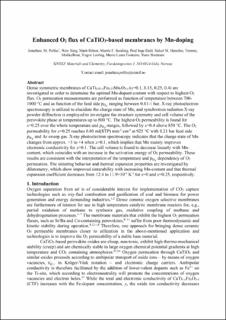Enhanced O2 flux of CaTi0.85Fe0.15O3 – d based membranes by Mn doping
Polfus, Jonathan M.; Xing, Wen; Riktor, Marit Dalseth; Sunding, Martin Fleissner; Dahl, Paul Inge; Hanetho, Sidsel Meli; Mokkelbost, Tommy; Larring, Yngve; Fontaine, Marie-Laure; Bredesen, Rune
Peer reviewed, Journal article
Accepted version
Permanent lenke
https://hdl.handle.net/11250/2720617Utgivelsesdato
2016Metadata
Vis full innførselSamlinger
- Publikasjoner fra CRIStin - SINTEF AS [5801]
- SINTEF Industri [1565]
Originalversjon
Journal of The American Ceramic Society. 2016, 99 (3), 1071-1078. 10.1111/jace.14022Sammendrag
Dense symmetric membranes of CaTi0.85−xFe0.15MnxO3−δ (x = 0.1, 0.15, 0.25, 0.4) are investigated in order to determine the optimal Mn dopant content with respect to highest O2 flux. O2 permeation measurements are performed as function of temperature between 700°C–1000°C and as function of the feed side urn:x-wiley:00027820:media:jace14022:jace14022-math-0003 ranging between 0.01 and 1 bar. X‐ray photoelectron spectroscopy is utilized to elucidate the charge state of Mn, and synchrotron radiation X‐ray powder diffraction (SR‐XPD) is employed to investigate the structure symmetry and cell volume of the perovskite phase at temperatures up to 800°C. The highest O2 permeability is found for x = 0.25 over the whole temperature and urn:x-wiley:00027820:media:jace14022:jace14022-math-0004 ranges, followed by x = 0.4 above 850°C. The O2 permeability for x = 0.25 reaches 0.01 mL(STP) min−1 cm−1 at 925°C with 0.21 bar feed side urn:x-wiley:00027820:media:jace14022:jace14022-math-0005 and Ar sweep gas. X‐ray photoelectron spectroscopy indicates that the charge state of Mn changes from approx. +3 to +4 when x > 0.1, which implies that Mn mainly improves electronic conductivity for x > 0.1. The cell volume is found to decrease linearly with Mn content, which coincides with an increase in the activation energy of O2 permeability. These results are consistent with the interpretation of the temperature and urn:x-wiley:00027820:media:jace14022:jace14022-math-0006 dependency of O2 permeation. The sintering behavior and thermal expansion properties are investigated by dilatometry, which show improved sinterability with increasing Mn content and that the thermal expansion coefficient decreases from 12.4 to 11.9 × 10−6 K−1 for x = 0 and x = 0.25, respectively.
